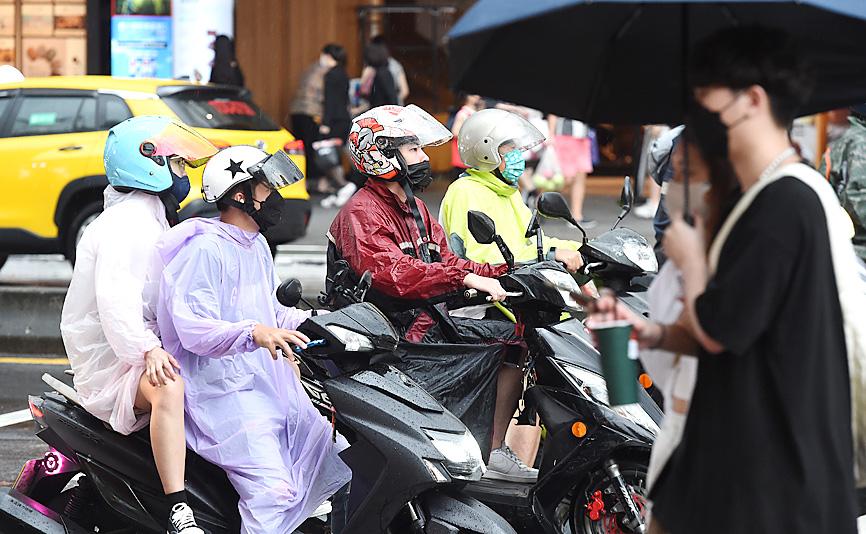Foreign nationals visiting Taiwan for six purposes are to be allowed entry starting on Monday next week, the Central Epidemic Command Center (CECC) announced yesterday, adding that people would no longer be required to wear a mask when riding a bike or a scooter, or when working in an open outdoor space, effective immediately.
Bureau of Consular Affairs Deputy Director Chou Chung-hsing (周中興) said the six purposes are volunteer work, missionary work, religious studies, internship, international exchange and foreigners on a working holiday.
Foreign nationals, not including residents of Hong Kong or Macau, who are planning to visit Taiwan for these six purposes can prepare the required documents and apply for a visa at the consular services office in their nation from Monday next week, he said.

Photo: Liao Chen-huei, Taipei Times
Foreigners eligible for the working holiday visas are limited to those from nations with reciprocal working holiday or youth exchange agreements with Taiwan, Chou said, adding that Taiwan has agreements with 17 nations and most have already allowed entry to Taiwanese, so they are included in the eligibility expansion based on the principles of equality and reciprocity.
There were about 10,000 people in the six categories who visited Taiwan each year before the COVID-19 pandemic, so considering the current inbound traveler cap of 40,000 people per week, allowing entry to these people should still be manageable, he said.
Meanwhile, Deputy Minister of Health and Welfare Victor Wang (王必勝), who heads the CECC, announced that domestic mask regulations have been slightly eased.
The changes include no longer requiring people to wear a mask when riding a bicycle, scooter or motorcycle, or when working in an open outdoor area, Wang said, adding that an open area means that the individual can keep a safe social distance from strangers and an example would be construction workers.
Asked if people must still wear a mask when taking a walk, Wang said taking a walk can be considered doing exercise, so wearing a mask is not required.
He also announced that Deputy Minister of Economic Affairs Chen Chern-chyi (陳正祺) and Deputy Minister of Transportation and Communications Chen Yen-po (陳彥伯) have joined the CECC’s team as deputy heads to assist the center in policies regarding resources preparation, economic revitalization, tourism development, hotel management, crowd flow and logistics.
Centers for Disease Control Director-General Chou Jih-haw (周志浩), head of the CECC’s disease surveillance division, said 26,779 new local infections and 367 imported cases were reported yesterday, as well as 37 deaths.
The caseload is slightly lower than Tuesday last week, but imported cases have been gradually increasing in the past five weeks, which reflects the trend in other nations and could be due to eased border control measures, Chou said, adding that the number of deaths is the lowest since May 16 and hopefully the number would continue to fall.

‘CHARM OFFENSIVE’: Beijing has been sending senior Chinese officials to Okinawa as part of efforts to influence public opinion against the US, the ‘Telegraph’ reported Beijing is believed to be sowing divisions in Japan’s Okinawa Prefecture to better facilitate an invasion of Taiwan, British newspaper the Telegraph reported on Saturday. Less than 750km from Taiwan, Okinawa hosts nearly 30,000 US troops who would likely “play a pivotal role should Beijing order the invasion of Taiwan,” it wrote. To prevent US intervention in an invasion, China is carrying out a “silent invasion” of Okinawa by stoking the flames of discontent among locals toward the US presence in the prefecture, it said. Beijing is also allegedly funding separatists in the region, including Chosuke Yara, the head of the Ryukyu Independence

UNITED: The premier said Trump’s tariff comments provided a great opportunity for the private and public sectors to come together to maintain the nation’s chip advantage The government is considering ways to assist the nation’s semiconductor industry or hosting collaborative projects with the private sector after US President Donald Trump threatened to impose a 100 percent tariff on chips exported to the US, Premier Cho Jung-tai (卓榮泰) said yesterday. Trump on Monday told Republican members of the US Congress about plans to impose sweeping tariffs on semiconductors, steel, aluminum, copper and pharmaceuticals “in the very near future.” “It’s time for the United States to return to the system that made us richer and more powerful than ever before,” Trump said at the Republican Issues Conference in Miami, Florida. “They

GOLDEN OPPORTUNITY: Taiwan must capitalize on the shock waves DeepSeek has sent through US markets to show it is a tech partner of Washington, a researcher said China’s reported breakthrough in artificial intelligence (AI) would prompt the US to seek a stronger alliance with Taiwan and Japan to secure its technological superiority, a Taiwanese researcher said yesterday. The launch of low-cost AI model DeepSeek (深度求索) on Monday sent US tech stocks tumbling, with chipmaker Nvidia Corp losing 16 percent of its value and the NASDAQ falling 612.46 points, or 3.07 percent, to close at 19,341.84 points. On the same day, the Philadelphia Stock Exchange Semiconductor Sector index dropped 488.7 points, or 9.15 percent, to close at 4,853.24 points. The launch of the Chinese chatbot proves that a competitor can

‘VERY SHALLOW’: The center of Saturday’s quake in Tainan’s Dongshan District hit at a depth of 7.7km, while yesterday’s in Nansai was at a depth of 8.1km, the CWA said Two magnitude 5.7 earthquakes that struck on Saturday night and yesterday morning were aftershocks triggered by a magnitude 6.4 quake on Tuesday last week, a seismologist said, adding that the epicenters of the aftershocks are moving westward. Saturday and yesterday’s earthquakes occurred as people were preparing for the Lunar New Year holiday this week. As of 10am yesterday, the Central Weather Administration (CWA) recorded 110 aftershocks from last week’s main earthquake, including six magnitude 5 to 6 quakes and 32 magnitude 4 to 5 tremors. Seventy-one of the earthquakes were smaller than magnitude 4. Thirty-one of the aftershocks were felt nationwide, while 79